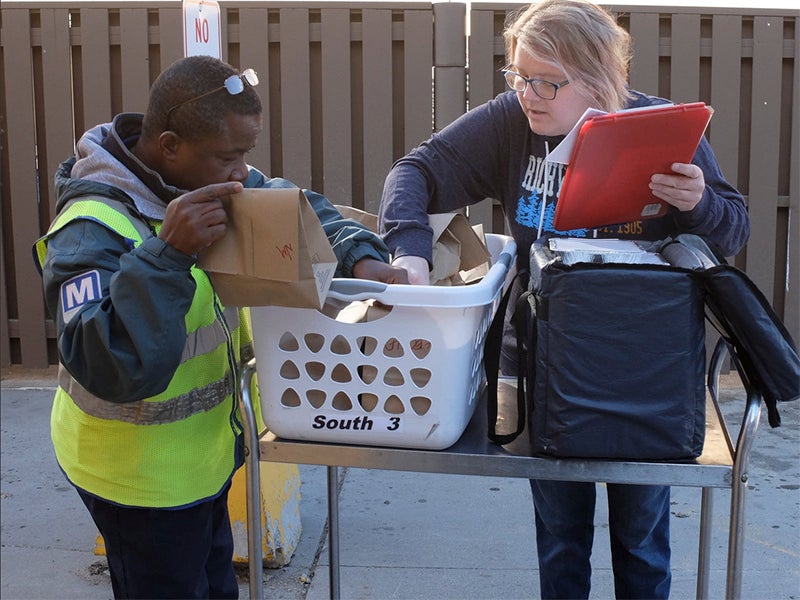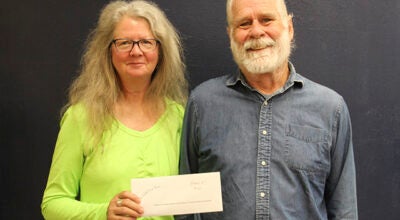Proposed shift in funding for older adult services worries rural providers
Published 2:01 pm Monday, May 1, 2023

- Andrea Pollock helps Osbert Duoa arrange meals to be delivered to senior citizens in Moorhead. Metro transit bus drivers teamed up with volunteers to make sure meals were delivered during the pandemic. Dan Gunderson/MPR News 2020
|
Getting your Trinity Audio player ready...
|
By Dan Gunderson, Minnesota Public Radio News
A proposed revision in the funding formula for programs that serve older adults in Minnesota is raising concerns in rural areas of the state.
The Dancing Sky Area Agency on Aging covers 21 northwestern Minnesota counties.
Director Heather Pender expects a change in the state formula for distributing federal funds for programs will mean a cut of nearly $200,000.
“The biggest program that we fund is our meals on wheels, so that is probably the area that in our office will take the largest hit,” said Pender. “It’s concerning because we saw an increase in meals with the pandemic and the need is there probably more than ever for seniors to have nutrition that is healthy and stable, something that keeps them in their homes or communities longer.”
Dancing Sky Area Agency on Aging is one of seven organizations across the state that receive funds and distribute them to local programs that provide a range of services to seniors.
Many of the organizations in rural areas expect a reduction in funding under the revised formula used to distribute more than $23 million in federal aid. It’s the first such change in nearly 20 years. The Board on Aging said the formula would shift about $800,000 from Greater Minnesota to the Twin Cities metro region.
Funding shift
“There would be a shift even if we did not change the funding formula at all, because of the change in population,” said Minnesota Board on Aging executive director Kari Benson. “And we take that very seriously. We’ve really been grappling with how can we capture the costs and the needs associated with serving older adults in rural areas as well as older adults in diverse communities.”
Federal requirements influence how the formula is set, said Benson. It must reflect demographics across the state and make sure that the federal Older Americans Act funding is targeted to older adults in greatest social and economic need.
The Board on Aging also assigns weights to different demographics in the formula, increasing the percentage of funding targeted to those groups based on geography, race and other factors.
Some rural providers want a greater priority given to rural populations.
Southeastern Minnesota Area Agency on Aging serves 11 counties and director Laurie Brownell expects a range of programs from congregate and delivered meals to caregiver support will be affected by a projected cut of $250,000.
“The reality is that some programs may not be able to continue to operate with the reduced level of funding,” Brownell said. “Often times OAA (Older Americans Act) services are the only services available in rural communities and they do not have the same number of funding sources and services that non-rural areas have.”
Those concerns are echoed by Lori Vrolson, executive director of the Central Minnesota Council on Aging which serves 14 counties across central Minnesota.
“Rural communities face many health care and social services access challenges that contribute to longstanding health disparities compared with older adults living in the seven-county metro area,” said Vrolson, who is urging the board to adjust the way it prioritizes or weights the different demographic categories.
Vrolson contends rural populations should receive a higher weight in the formula than is currently proposed.
“Research shows that rural individual are more likely to die from heart disease, cancer, unintentional injury, chronic disease and stroke than those living in urban areas. These disparities are closely tied to the social determinants of health including higher rates of poverty, limited access to health care providers and lack of transportation,” she said.
Significant reduction of services
The potential financial implications will be multiplied if the funding formula changes at the same time as federal stimulus dollars provided during the pandemic wind down. That funding allowed many agencies to expand services for older adults.
“We will be looking to significantly reduce our programs,” said Jason Swanson, executive director of the Minnesota River Area Agency on Aging, serving 27 southwestern Minnesota counties.
“Simple interventions and prevented care go a long way to assisting older adults. These are on the cusp of being retracted and potentially removed from some communities. Limiting services at a time where there are more older adults than school age children will only put more stress on our hospitals, nursing homes and assisted living (facilities).”
The Board on Aging will take public comments on the proposed funding reallocation through May 3, and will then consider whether to make changes based on those comments.
But there are no easy decisions when the pot of available money has not increased with growing demand, said Benson.
“The needs currently of the older adult population already exceed the resources that we have available through our state and federally funded programs,” she said. “We have work to do.”




